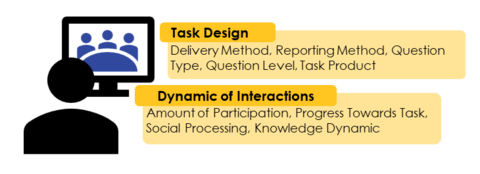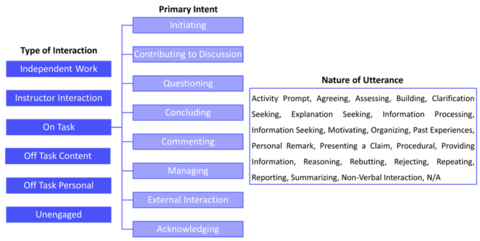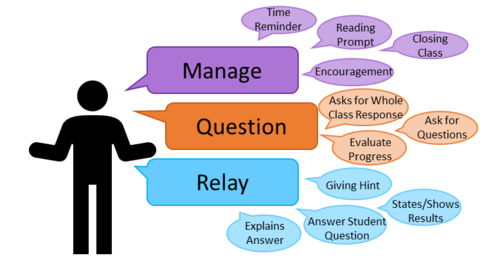Using Discourse Analysis to Investigate Student Interactions and Effects of Instructional Practices Across Multiple Settings
The increased adoption of active learning strategies to teach chemistry at the undergraduate level provides a unique opportunity to investigate how students develop understanding of concepts in chemistry and the nature of the classroom environment that supports (or constrains) this development. Student experiences in introductory courses are important because this time is when students are deciding their majors, careers, and other life goals. It is important to understand the effectiveness of active learning strategies in large enrollment courses because many undergraduate introductory courses are taught in larger classrooms. The specific goals of this project are:
To characterize the way students interact while engaged in their lecture and discussion coursework
To characterize the way students use language to discuss scientific phenomenon in both lecture and small classroom discussions
To analyze how instructional practices effect the way students communicate in active learning classrooms.
We focus on the shifts of knowledge among individuals, small groups, and the whole class community, and hence on the relationship between knowledge constructed by individuals and the collective activity of the classroom community. This research is expected to lead to theoretical understanding of and methodological advances for characterizing, documenting and coordinating individual and collective progress in chemistry accomplished in classrooms with active learning environments. This project collects and interprets data about student reasoning that will inform the STEM education community about student learning. The results of the research will provide additional insights into how instructional strategies and the design of curricular materials improve (or hinder) student understanding of chemistry. These insights can then be applied to develop improved models for curriculum development and pedagogical strategies for chemistry and other STEM disciplines.
Characterizing Task Design and Student Group Interactions

In the past decade, there has been increased emphasis on research-based instructional practices in STEM fields, specifically in terms of student-centered active learning approaches. Much of this drive for pedagogical change has come from the numerous publications on the positive impact active learning environments have on student outcomes in large introductory courses, particularly for students who have historically been underserved in STEM fields. However, more work is needed to understand how students engage in these courses to provide insights on how to promote more effective active learning environments. This project is focused on characterizing the essential features of effective task design and implementation that foster productive engagement of diverse students in discourse practices known to promote meaningful learning in different active learning environments.
Characterizing and Visualizing Student Discourse Patterns

Student-centered instruction allows students to take ownership over their learning. Social, environmental, and cultural factors influence how students learn and interact in the classroom. Previous analyses of student engagement in science settings have primarily focused on frequency counts to measure quality of student interactions. However, these methods do not capture the intricacies of student group interactions such as the flow of conversation and nature of student utterances. These are important if we want to accurately assess the quality of student engagement. This work expands upon the STEM discourse analysis literature by developing a tiered analytical framework along with a visualization scheme to characterize group discussion patterns while students work through classroom activities. This framework was designed to characterize student behavior at varying levels – Type of Student Interaction, Primary Intent, and Nature of Utterance. This more detailed level of analysis allows for the identification of productive discourse characteristics, which can be visualized using the proposed discourse maps. The major finding from this work shows that frequency counts alone cannot tell the full story of student engagement, even though they are the most commonly reported values in STEM classroom research. Frequency counts do not account for the nature of students’ contributions which provide valuable insights into the progression of student conversation and the quality of student contributions. Implications from this work can be used to extend studies using discourse analysis to determine how students work through problems and what instructors can do to promote productive discourse in student-centered science classrooms.
Understanding Facilitation of Active Learning Practices

It is important for instructors to create inclusive learning environments so that all student populations feel accepted into the scientific community and persist throughout the program. Facilitation styles of instructors shape the classroom environment. Factors such as the cognitive level of tasks, the amount of time allotted for a task, and the nature in which the task is introduced affect student participation with active learning activities. These factors are inputs into a student’s framing of the classroom environment and affect the ways students interact within it. Instructor facilitation has been shown to play a critical role in students’ understanding of macroscopic, sub-microscopic, and symbolic ideas in other chemistry contexts as well. Therefore, we are also interested at looking at the how an instructor influences the discourse taking place in the classroom. Correlating the discursive moves of the instructor to the presence and quality of student discussions can provide insights into understanding effective facilitation of active learning environments.